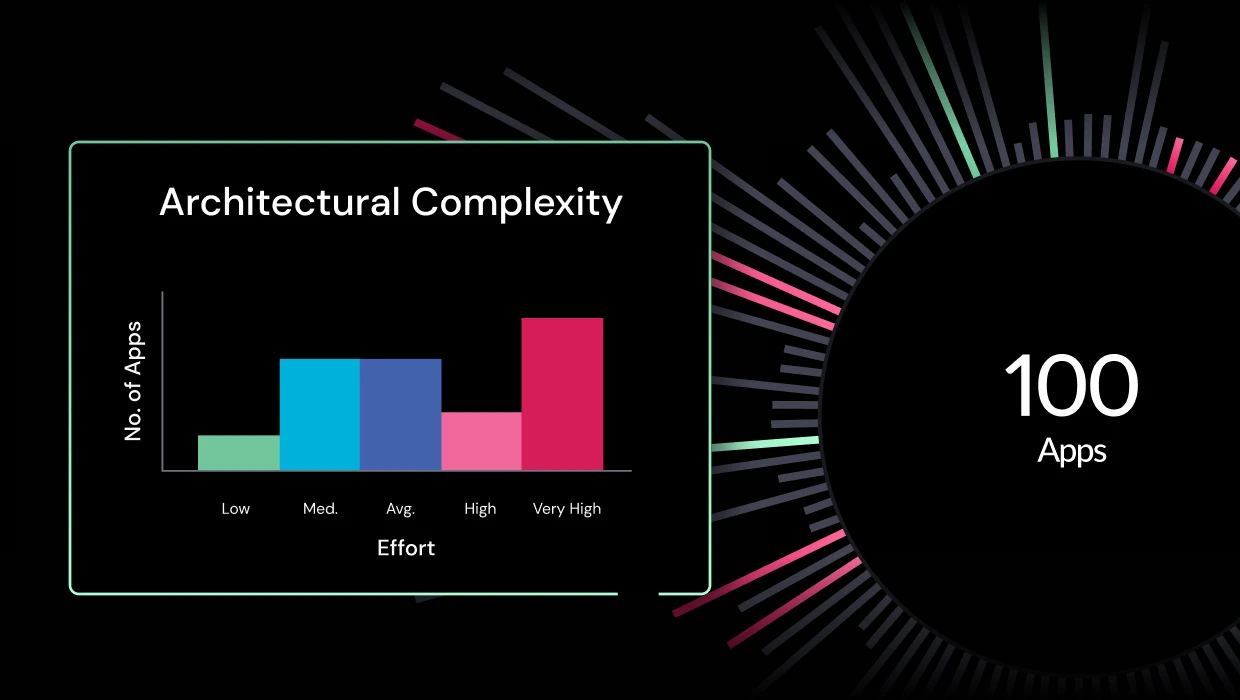Distributed architectures such as microservices offers several advantages over monolithic architectures. Microservices are self-contained code that can be deployed independently. Developers can focus on a few microservices rather than the entire codebase, reducing onboarding time. If a failure occurs in a microservice, it does not create a cascading failure that results in significant downtime.
Indeed, compared to older, legacy applications, today’s applications must be more scalable and cloud-ready. Response times need to be faster. Data needs to move quicker. Performance must be reliable. Meeting these demands becomes more challenging as monolithic legacy structures exceed their original design capacities.
Experts expect that the world will generate more data over the next three years than it has in the last three decades. This exponential growth in data processing requirements far exceeds those anticipated when systems were designed ten or twenty years ago. Legacy systems were never intended to run in the cloud or meet the 21st century’s performance requirements. Modernization is no longer an option. It has become an imperative.
The Importance of Making the Move from Monolith to Microservices: Who Wants to Be a Headline?
Recent high-profile failures have highlighted the risks of ignoring technical debt and maintaining legacy software instead of modernizing it. Southwest Airlines had a very public meltdown of its scheduling system. Twitter has experienced unplanned disruptions. While the exact source of the problem may be different, the root cause was old, brittle code that could not handle increased demand.
As is often the case, companies opt for faster delivery of new features rather than performance. They overlook the architectural issues that result from pushing a system beyond its design thresholds. Instead, they accumulate technical debt and operate on borrowed time.
Operating on Borrowed Time
The longer an organization waits to address their technical debt issues and start to incrementally modernize, the greater the potential impact on operations. What might have been an isolated change when first discovered soon becomes a problem with ripple effects that risk hours of downtime. Executives fearing the consequences of system upgrades or replacements wait until time has run out.
Paying the Price
Modernizing software in a big-bang approach is costly. All those hours that were not spent strengthening a system are suddenly required—and at a rate that is far higher than when the original solution was deployed. Most development or IT budgets are not large enough to cover the expense of modernizing an entire application at once. Without an incremental approach to remove legacy code, systems remain in place beyond their “best used by” date because no one wants to pay the price.
Maintaining the Status Quo
Even when modernization projects are authorized, many fail to achieve a successful outcome because the change that comes with the project is too complex for the existing corporate culture to implement. Modernization requires architectural observability and a continuous DevOps-like approach to software development and deployment to create a more efficient and agile environment.
Related: Application Modernization Trends, Goals, Challenges, and Resources
The approach requires a continuous modernization methodology, similar to continuous integration and deployment (CI/CD) methods, to deliver software incrementally. It establishes a philosophy that addresses technical debt as part of normal operations. It also used automation tools to help expedite the process. These changes often require a significant reorientation of existing systems. Without a plan, continuous modernization projects are likely to fail.
Being the Lead Story
Avoiding the headlines means having a plan and knowing what technical issues have priority. Companies ensure they are not front-page news by understanding the value microservices principles have for software development and delivery. Most importantly, organizations must acknowledge that successful implementations require change.
Business Benefits of Making the Move
Aside from being the next headline, organizations need to understand the why, when, and how of modernization. Understanding the business benefits that come with a distributed architecture, such as microservices, can encourage decision-makers to move forward with modernization.
Scalability
When a module in a monolithic application needs additional resources, the entire application must scale. On-premise deployments may require massive investments in added hardware to scale the whole application.
But because microservices scale individually, IT only needs to allocate sufficient resources for a given microservice. Combining microservice architecture with cloud elasticity simplifies scaling. Cloud-based microservice architecture can respond automatically to fluctuations in demand.
When more resources are needed during Black Friday sales, for example, order-processing microservices can scale to meet demand. Two weeks later, when demand stabilizes, resources can be scaled back.
Resiliency
Resiliency looks at individual failures. Resilient systems discover and correct flaws before they turn into system failures that require redundant systems. They also identify and correct flaws that can lead to micro-outages. For example, downtime costs a small business $427 per minute—and that number can shoot up to $9,000 for larger organizations.
Suppose a business with 100 employees experiences two minutes of downtime. At $9,000 a minute, those two minutes cost $1,800,000 ($18,000×100). Because resilient systems have built-in recovery capabilities, they can isolate and contain flaws to minimize costly micro-outages.
Microservice architecture lends itself to resiliency, as each service is self-contained. If external resources are needed, they are accessed using APIs. If necessary, a microservice can be taken offline without impacting the rest of the application. Monolithic structures, on the other hand, operate as one large application, making error isolation difficult to achieve.
Agility
As end users demanded more functionality and faster delivery, developers have in parallel adopted an agile approach. They work to deliver improvements incrementally rather than accumulating fixes for a single delivery. Microservices work well in an agile environment. Changes can be deployed at the microservices level with minimal impact on the rest of the application.
If an immediate fix is required, only the flawed microservice needs to be touched. When it’s time to deploy, only part of the application is involved. Unlike monolithic applications, efforts are limited to a smaller percentage of the code base for faster delivery of software changes. With microservices, only the affected code is released, reducing the impact on operations should an update need to be rolled back.
Observability
End-to-end visibility in a microservices environment can be challenging. Until recently, tools were unavailable that consolidated system-wide monitoring into a single view of the software. Instead, operations had to comb through logs and traces to locate abnormalities.
A new generation of architectural observability tools designed to analyze and detect architectural drift now gives organizations the ability to manage and continuously remediate technical debt. Proactive problem-solving becomes possible. Performance concerns can be addressed before they impact operations, creating more reliable applications.
Cloud Computing
Organizations moving from monolith to microservices can take advantage of cloud computing. Leveraging the internet-based availability of computer services allows companies to reduce costs for servers, data storage, and networking. Rather than store and run enterprise workloads and apps on-premises, cloud computing enables IT departments, employees, and customers remote access to computer functions and data.
When to Begin Transitioning to a Microservices Architecture
Moving to a microservices architecture requires preparation. It requires a corporate commitment to fuel the culture change that is necessary and includes new Agile and DevOps processes. Organizations need to determine where their technical debt stands, how they plan to reduce it, and what they want to achieve. Skipping a clear technical debt analysis can lead to costly, confusing, and potentially devastating errors.
Analyze the Environment
Embracing microservices means creating a culture that maximizes its strengths. It requires building a DevOps approach to development and deployment. Development teams should understand how agile techniques work with microservices for faster and more reliable software. If these are not in place, a successful move is unlikely.
Management support is vital to transitioning to microservices. Not only do the dollars need to be authorized, but business objectives need to align. Executives must be willing to collaborate with IT to create a positive environment for change. If the business and technical environments are not established, then the transition process should begin there.
Define Objectives
IT departments can define what monolithic code should be moved to microservices while initial assessments are conducted. They can start with desired outcomes. What should modernization achieve? Better performance? Easier Scaling? Without a clearly-defined outcome, establishing priorities and creating a roadmap are challenging.
Microservice projects should also have business objectives. These objectives may include improved customer experience through faster payment processing or persisting data during an online application session. Whatever the objective, the technical outcomes need to support the business objectives. Establishing clear technical outcomes that align with business objectives is the second phase in moving from monolithic to microservices.
Measure Technical Debt
IT departments cannot quantify their modernization efforts until they measure their technical debt. They can use different calculation methods, such as tracking the number of new defects being reported or establishing metrics to assess code quality. Developers can monitor the amount of rework needed on production code. Increasing rework often indicates a growing technical debt.
Related: Modernizing Legacy Code: Refactor, Rearchitect or Rewrite
Whatever method is used, IT teams should look for automated tools that can simplify the process. Manual processes are labor-intensive and prone to error when subjective criteria are used. Automation provides a consistent evaluation method for quantifying technical debt.
Begin Transition
Once organizations have analyzed the environment, defined the objectives, and measured their technical debt, they can begin their transition to microservice architectures. They can determine which modernization strategies to use and decide how to assign priorities. They should also identify what tools and methods are needed.
7 Steps for Moving from Monolith to Microservices
As companies begin moving monolithic code to microservices, they need to evaluate the existing code to determine which components should be moved. Not every component is right for refactoring into a microservice. Sometimes, teams should consider other modernization strategies.
- Identify Modernization Strategies
Every company has different priorities when it comes to modernization. Businesses have sales goals and departments have budgets. When faced with these constraints, organizations should consider the following strategies:
- Replace. Purchasing new solutions is always an option when it comes to removing legacy code.
- Retain. Some parts of existing code may be kept as is. Based on budget and delivery schedules, existing code with minimal technical debt may remain in use.
- Rewrite. Starting over can be an appealing option, but rewriting an entire application is labor-intensive. It’s not just rewriting an application. It’s also re-architecting the existing software.
- Retire. Removing software that is no longer needed helps simplify a system; however, the software should be carefully monitored to ensure no functionality is lost.
- Refactor. Manual refactoring is too resource-intensive for most migrations. Automated tools are a cost-effective way to move monolithic applications to microservices.
Knowing which strategies to apply helps determine the level of effort for each modernization project. It helps set priorities to ensure that critical code is addressed first.
- Set Priorities
Organizations must examine the impact of legacy code on operational risk and resource use when setting priorities. They should look at what constraints monolithic architectures are placing on innovation. When old code makes it difficult to maintain a competitive advantage, it threatens business growth.
With high levels of tech debt, organizations often lack the agility they need to use the latest technologies. Gaining valuable data-driven insights requires cloud computing capabilities. Monoliths are not cloud-native, which limits their ability to integrate seamlessly with the cloud.
Establishing operational-risk priorities should involve more than system failures. IT departments need to assess the security risks associated with older code. Hackers use known vulnerabilities found in older code to breach defenses.
Brittle systems make maintenance challenging. Developers must take extra care to ensure a fix in one module doesn’t compromise another. The added effort comes at a cost, as valuable resources are consumed fixing old code rather than creating new functionality.
As IT departments set priorities, they must balance the impact of the monolith on existing operations. They must also balance the resources required to effect that change. They may want to apply the 80/20 rule—focusing on the 20% of their applications that are creating 80% of the problems.
- Adopt Architectural Observability Methods
Opting to move from monolith to microservice means adopting architectural observability methods that ensure migration success. Rather than following a waterfall approach, teams should use continuous modernization. They should rely on automated solutions that work with a continuous integration and deployment (CI/CD) process for faster and more reliable deliveries. DevOps approaches can facilitate the move with monitoring and observability tools that help control technical debt and architectural drift.
- Employ Continuous Modernization
Continuous modernization is an iterative process of delivering software changes. It complements microservices because changes can be deployed to an application based on the microservices being touched. Updates do not have to wait until the entire application is released. Customers receive new features faster with less risk of catastrophic failures.
- Leverage Automation
Modernization platforms offer automated tools to help with continuous modernization. These platforms can analyze architectures to assess architectural drift. They can refactor applications into microservices and provide observability as the software is deployed.
Automated tools can exercise and analyze code much faster than testing staff. They can ensure consistency in testing, apply best practices, and operate 24/7. Automation goes hand-in-hand with continuous modernization. Without automation, the iterative process of software delivery will struggle to reach its full potential.
- Streamline with DevOps
DevOps combines software development and operations into collaborative teams. The teams work together to deliver projects that meet business objectives. DevOps is concerned with maintaining a system that unifies and streamlines the CI/CD process through automation. A DevOps environment encourages a continuous modernization approach when moving from monolith to microservices.
DevOps teams monitor newly deployed systems to ensure operational integrity. They rely on metrics, logs, and traces; however, these tools lack the end-to-end visibility that organizations need. A crucial part of modernization is observability, particularly architectural observability.
- Ensure Performance Observability
Monitoring tools provide the granularity needed to identify potential problems at the component level. They provide information on what a microservice does. What they don’t provide is the ability to observe system operations across a distributed architecture.
Observability tools, on the other hand, assess an application’s overall health. They look beyond the individual microservice to provide context when anomalies are found. As systems increase in complexity, observability becomes an essential part of modernization.
Make the Move from Monolith to Microservices
Moving from monolith to microservices requires both a change in architecture and a collaborative approach that has architecture, security, and operations all shifting left. With that shift comes a reassessment of a company’s culture. Unless the environment is conducive to continuous modernization, projects may fail to meet expectations. Understanding the benefits of a microservices architecture is essential to determining the modernization strategies to use. It can help establish priorities. However, a successful migration depends on adopting continuous modernization methods and tools. vFunction’s Continuous Modernization Platform is an automated solution that delivers essential architectural observability for assessing technical debt and architectural drift. Request a demo today to see how it can transform your modernization efforts.






